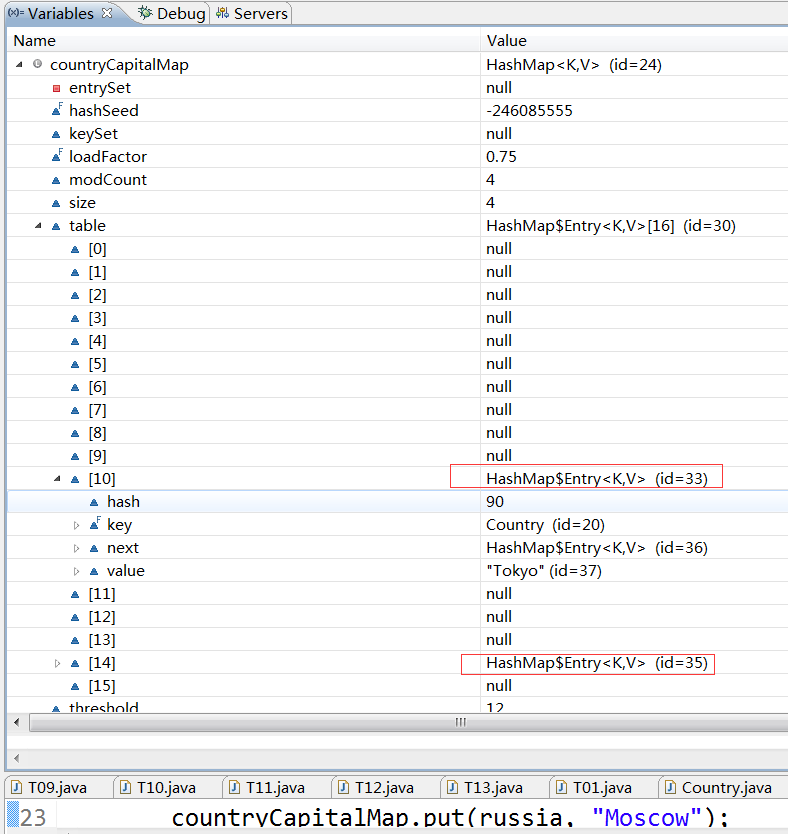HashMap整体结构

HashMap由数组+链表组成的,数组是HashMap的主体,链表则是主要为了解决哈希冲突而存在的,
如果定位到的数组位置不含链表(当前entry的next指向null),那么对于查找,添加等操作很快,仅需一次寻址即可;
如果定位到的数组包含链表,对于添加操作,其时间复杂度依然为O(1),因为最新的Entry会插入链表头部,急需要简单改变引用链即可,
而对于查找操作来讲,此时就需要遍历链表,然后通过key对象的equals方法逐一比对查找。所以,性能考虑,HashMap中的链表出现越少,性能才会越好。
package hash; public class Country { String name; long population; public Country(String name, long population) { super(); this.name = name; this.population = population; } public String getName() { return name; } public void setName(String name) { this.name = name; } public long getPopulation() { return population; } public void setPopulation(long population) { this.population = population; } // If length of name in country object is even then return 31(any random // number) and if odd then return 95(any random number). // This is not a good practice to generate hashcode as below method but I am // doing so to give better and easy understanding of hashmap. @Override public int hashCode() { System.out.println(this.name.length()+"-----------"); if (this.name.length() % 2 == 0) return 31; else return 95; } @Override public boolean equals(Object obj) { Country other = (Country) obj; if (name.equalsIgnoreCase((other.name))) return true; return false; } }
1 package hash; 2 3 import java.util.HashMap; 4 import java.util.Iterator; 5 6 public class HashMapStructure { 7 8 /** 9 * @param args 10 */ 11 public static void main(String[] args) { 12 // TODO Auto-generated method stub 13 Country india = new Country("India", 1000); 14 Country japan = new Country("Japan", 10000); 15 16 Country france = new Country("France", 2000); 17 Country russia = new Country("Russia", 20000); 18 19 HashMap<Country, String> countryCapitalMap = new HashMap<Country, String>(); 20 countryCapitalMap.put(india, "Delhi"); 21 countryCapitalMap.put(japan, "Tokyo"); 22 countryCapitalMap.put(france, "Paris"); 23 countryCapitalMap.put(russia, "Moscow"); 24 25 Iterator<Country> countryCapitalIter = countryCapitalMap.keySet() 26 .iterator();// put debug point at this line 27 while (countryCapitalIter.hasNext()) { 28 Country countryObj = countryCapitalIter.next(); 29 String capital = countryCapitalMap.get(countryObj); 30 System.out.println(countryObj.getName() + "----" + capital); 31 } 32 } 33 34 }

1. 有一个叫做table大小是16的Entry数组。
2. 这个table数组存储了Entry类的对象。HashMap类有一个叫做Entry的内部类。这个Entry类包含了key-value作为实例变量。我们来看下Entry类的结构。Entry类的结构:
1 static class Entry implements Map.Entry 2 { 3 final K key; 4 V value; 5 Entry next;//存储指向下一个Entry的引用,单链表结构 6 final int hash;//对key的hashcode值进行hash运算后得到的值,存储在Entry,避免重复计算 7 ...//More code goes here 8 }
3. 每当往hashmap里面存放key-value对的时候,都会为它们实例化一个Entry对象,这个Entry对象就会存储在前面提到的Entry数组table中。
而上面创建的Entry对象将会存放在具体哪个位置(在table中的精确位置),是根据key的hashcode()方法计算出来的hash值(来决定)。hash值用来计算key在Entry数组的索引。
4. 上图中数组的索引10,它有一个叫做HashMap$Entry的Entry对象。 我们往hashmap放了4个key-value对,但是看上去好像只有2个元素!!!
这是因为如果两个元素有相同的hashcode,它们会被放在同一个索引上。问题出现了,该怎么放呢?原来它是以链表(LinkedList)的形式来存储的(逻辑上)。
HashMap:put方法
1 public V put(K key, V value) { 2 if (key == null) 3 return putForNullKey(value); 4 int hash = hash(key.hashCode()); 5 int i = indexFor(hash, table.length); 6 for (Entry<k , V> e = table[i]; e != null; e = e.next) { 7 Object k; 8 if (e.hash == hash && ((k = e.key) == key || key.equals(k))) { 9 V oldValue = e.value; 10 e.value = value; 11 e.recordAccess(this); 12 return oldValue; 13 } 14 } 15 16 modCount++; 17 addEntry(hash, key, value, i); 18 return null; 19 }
- 对key做null检查。如果key是null,会被存储到table[0],因为null的hash值总是0。
-
static final int hash(Object key) { int h; return (key == null) ? 0 : (h = key.hashCode()) ^ (h >>> 16); }
- key的hashcode()方法会被调用,然后计算hash值。hash值用来找到存储Entry对象的数组的索引。有时候hash函数可能写的很不好,所以JDK的设计者添加了另一个叫做hash()的方法,它接收刚才计 算的hash值作为参数。
- indexFor(hash,table.length)用来计算在table数组中存储Entry对象的精确的索引。
在例子中已经看到,如果两个key有相同的hash值(也叫冲突),他们会以链表的形式来存储。所以,这里我们就迭代链表。
- 如果在刚才计算出来的索引位置没有元素,直接把Entry对象放在那个索引上。
- 如果索引上有元素,然后会进行迭代,一直到Entry->next是null。当前的Entry对象变成链表的下一个节点。
- 如果再次放入同样的key会怎样呢?逻辑上,它应该替换老的value。事实上,它确实是这么做的。在迭代的过程中,会调用equals()方法来检查key的相等性(key.equals(k)),如果这个方法返回true,它就会用 当前Entry的value来替换之前的value。
HashMap:get方法
1 /** 2 * Returns the value to which the specified key is mapped, or {@code null} 3 * if this map contains no mapping for the key. 4 * 5 * <p> 6 * More formally, if this map contains a mapping from a key {@code k} to a 7 * value {@code v} such that {@code (key==null ? k==null : 8 * key.equals(k))}, then this method returns {@code v}; otherwise it returns 9 * {@code null}. (There can be at most one such mapping.) 10 * 11 * </p><p> 12 * A return value of {@code null} does not <i>necessarily</i> indicate that 13 * the map contains no mapping for the key; it's also possible that the map 14 * explicitly maps the key to {@code null}. The {@link #containsKey 15 * containsKey} operation may be used to distinguish these two cases. 16 * 17 * @see #put(Object, Object) 18 */ 19 public V get(Object key) { 20 if (key == null) 21 return getForNullKey(); 22 int hash = hash(key.hashCode()); 23 for (Entry<k , V> e = table[indexFor(hash, table.length)]; e != null; e = e.next) { 24 Object k; 25 if (e.hash == hash && ((k = e.key) == key || key.equals(k))) 26 return e.value; 27 } 28 return null; 29 }
当传递一个key从hashmap总获取value的时候:
- 对key进行null检查。如果key是null,table[0]这个位置的元素将被返回。
- key的hashcode()方法被调用,然后计算hash值。
- indexFor(hash,table.length)用来计算要获取的Entry对象在table数组中的精确的位置,使用刚才计算的hash值。
- 在获取了table数组的索引之后,会迭代链表,调用equals()方法检查key的相等性,如果equals()方法返回true,get方法返回Entry对象的value,否则,返回null。
摘要:
- HashMap有一个叫做Entry的内部类,它用来存储key-value对。
- 上面的Entry对象是存储在一个叫做table的Entry数组中。
- table的索引在逻辑上叫做“桶”(bucket),它存储了链表的第一个元素。
- key的hashcode()方法用来找到Entry对象所在的桶。
- 如果两个key有相同的hash值,他们会被放在table数组的同一个桶里面。
- key的equals()方法用来确保key的唯一性。
- value对象的equals()和hashcode()方法根本一点用也没有
(以上部分内容摘自:微信公众号Java团长-Java HashMap的工作原理)